AMD Radeon HD 6850 Overclocking Roundup: Asus, XFX, & MSI
by Ryan Smith on November 8, 2010 12:40 AM ESTOverclocking: Performance, Power, Temperature, & Noise
Half of our results focus on our 6850s at their stock clocks, but the other half of our results focus on the card when it comes to overclocking. As a lower clocked Barts card, 6850 cards not binned for poor maximum clocks should have a fair bit of overclocking room as AMD intended for the design to hit 900MHz+. The 6850’s power efficiency pretty much has to go out the window here, but in return we can capture some significant performance gains.
| Overclocking Results | ||||||
| Stock Clock | Max Overclock | Stock Voltage | Max Overclocked Voltage | |||
| Radeon HD 6850 Reference | 775MHz | 940MHz | 1.094v | 1.172v | ||
| XFX Radeon HD 6850 | 775MHz | 940MHz | 1.148v | 1.172v | ||
| MSI R6850 OC | 820MHz | 960MHz | 1.148v | 1.22v | ||
| Asus EAH6850 | 790MHz | 960MHz | 1.148v | 1.22v | ||
When overclocking, we found 3 things:
- All of the cards could hit 850MHz core at stock voltage
- All of the cards could hit 940MHz core at 1.172v, the 6870 load voltage
- We had to give the cards significantly more voltage to get above 940MHz. This culminated at 1.22v on the Asus and MSI cards for 960MHz
Based on these results we went ahead and benchmarked the Asus card at 850/1150, 940/1150, and 960/1150 to showcase the performance at these overclocks, while capturing data for all of the cards at 1.172v, and the Asus and MSI cards at 1.22v.
While it’s possible to hit 960MHz with enough voltage, in practice it’s not worth the effort. The Asus and MSI cards jumped in power consumption, temperature, and noise by around 20W, 3C, and 2dB each, for a performance difference of under 2%. On a higher-end card where performance is the only attribute that matters this wouldn’t really matter, but we would not consider this a useful tradeoff on a petite card like the 6850.
As for memory overclocking, we hit at solid wall at 1150MHz as none of our cards could do 1200MHz without artifacting. However 1150MHz didn’t trigger performance degradation due to error correction-induced retransmission, so it looks to be a safe frequency for all cards. The limit we believe lies solely with the memory controller, which was a conscientious decision by AMD to trade memory clocks for a smaller die. As a result the controller reaches its limit before we can even push the 5GHz GDDR5 to spec.
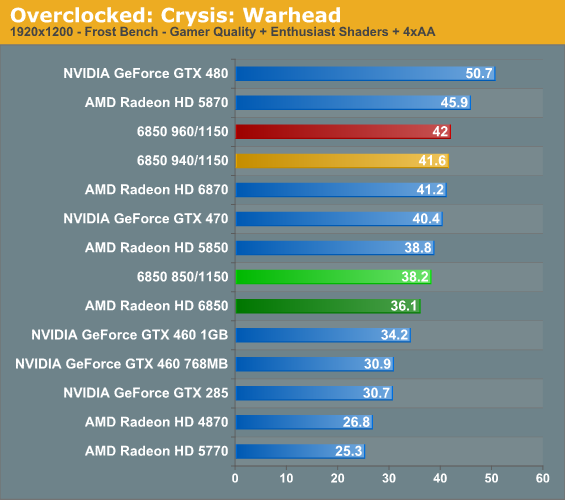
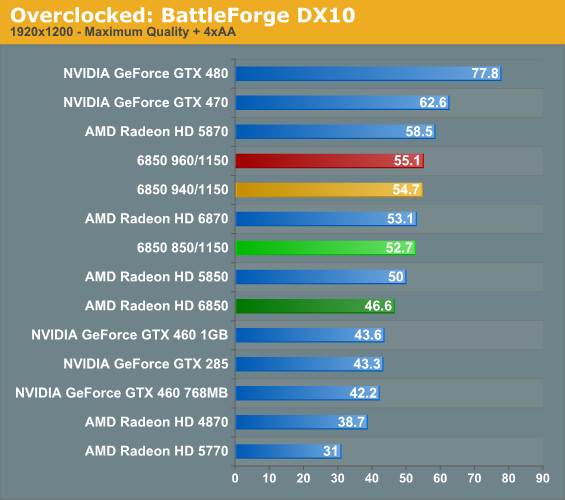


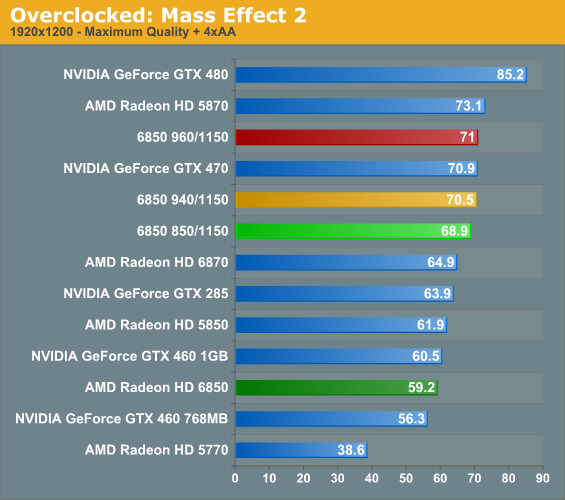
Something that caught us completely off-guard in our results is just how well the overclocked 6850 did. Even at the “mere” speed of 850/1150, it’s faster than the 6870 in 3 out of our 5 games; and the 6870 still has a core clockspeed advantage and more SIMDs! The advantage for our overclocked 6850s is that the memory clock of 1150MHz (4.6GHz effective) is faster than the 6870’s memory clock of 1050Mhz (4.2GHz effective), and this looks to be the reason for the difference. Based on all the data we have, Barts looks to be memory bandwidth starved in around half the games we use. From this it looks like a good memory overclock is going to go a long way on the 6850 and 6870 towards improving performance.
As for how much of an overclock is necessary, this depends on the game. When Barts is memory bandwidth starved, the 940Mhz and 960Mhz memory overclocks provide only a small boost; while on shader-bound games like Crysis there’s a very tangible benefit. Combine the memory overclock with a 940Mhz core overclock and the 6850 can meet or beat the 6870 every single time. The voltage increase necessary to achieve this core overclock comes at a price however.

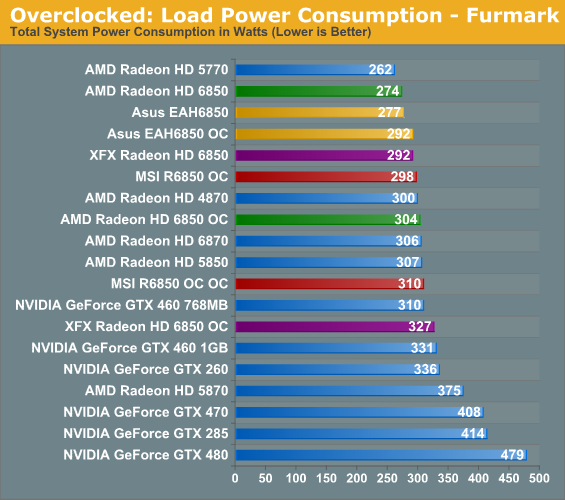
Starting with power consumption, the voltage increase necessary for 940MHz is around 20W-30W under FurMark for our reference and near-reference clocked cards, and less for the MSI card since it already has a notable factory overclock. If nothing else, 1.172v gives up all the power advantages over the Radeon 5850, though as we’ve seen it pays off with a very notable performance advantage over the 5850.
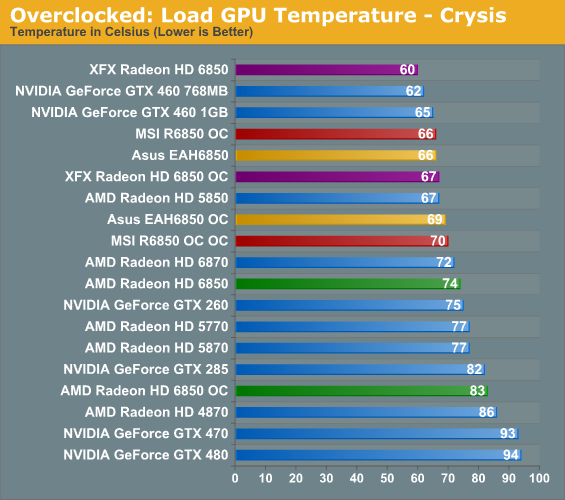

For the partner cards in today’s roundup, the temperature runup from overvolting isn’t too bad, with the worst card only hitting 81C under FurMark and becoming progressively cooler from there. However the reference 6850 is an entirely different story: it hits 93C under FurMark, which is hotter than what we’re comfortable with for Barts, particularly since it’s brand new. If reference-style cards show up on the market, we would not recommend overvolting them, at least not to 1.172v. Meanwhile the XFX card with its focus on temperature tops this chart, still only hitting 74C under FurMark. The cooling on this card is so good that we suspect the VRMs will burn up long before the GPU will when overvolting.
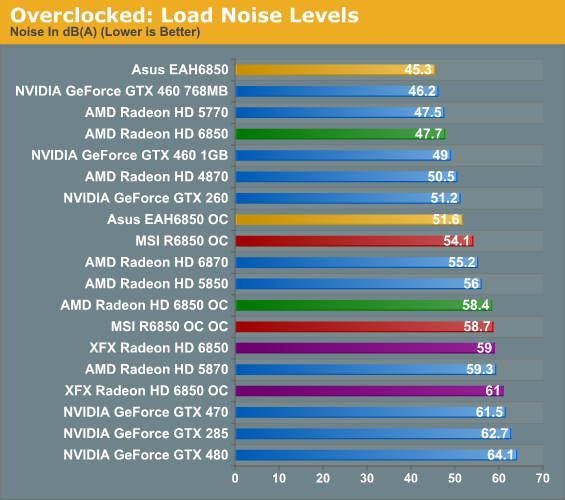
Finally we come to noise. We suspect many buyers will be alright with the power and temperature increases so long as noise remains manageable, so what we have is a mixed bag. Throwing out the reference 6850, we’re left with the XFX card at over 60dB, and while XFX’s focus on temperatures is commendable, it ends up being shortsighted by making the card exceptionally loud here. This is followed by the double-overclocked MSI card, which at 58.7dB is over 3dB louder than the 6870, but is only encroaching on the 5870. It’s too much noise for the performance, but compared to first-gen 40nm cards it’s not the end of the world.
This leaves us with the Asus card. While it does jump by 6dB due to our overclocking, it had such a massive lead at stock that this only makes it about as loud as the GTX 260 and Radeon HD 4870. The idea of a near-silent card has gone out the window at this point, but we would consider it a very manageable level of noise for the performance offed with the 940/1150 overclock. Certainly it’s the most balanced of the cards, as it sacrifices only little in the way of cooling (78C in FurMark) for the lower level of noise generated.










93 Comments
View All Comments
spigzone - Monday, November 8, 2010 - link
Ryan - "It was made abundantly clear to us in the comments in our follow-up piece and in emails to us that you guys disapproved of our inclusion of non-reference cards in articles."Your statement utterly disingenuous = DISHONEST.
It was crystal clear the howl that went up was specifically for using massively overclocked GTX460 cards in the FIRST REVIEW of the new AMD GPU series AND that it violated your own editorial policy on such 'first' reviews AND at that you didn't even include a Overdrive o/c'ed 6850/5870 for comparison.
It was ALSO crystal clear the readers DO want non-reference and o/ced cards in FOLLOW UP articles.
LIKE THIS ONE.
THIS IS WHERE ALL THOSE O/Ced AND NON-REFERENCE CARD STATS BELONG.
This is really disappointing.
And VERY dishonest.
7Enigma - Monday, November 8, 2010 - link
While a little harsh, this is pretty much dead on (once you weeded through all the fan-boy posts that had no sane basis other than a love/hate for their particular brand).And as mentioned the fix for this is so simple it shouldn't take more than an hour to correct. Put the 460 FTW in the charts, mention the pricing is more than the 6850 variants and let the buyers decide.
mapesdhs - Monday, November 8, 2010 - link
Hear hear!
The closing comment in the article is really dumb. Nobody in their right mind
would buy a stock 460 1GB for reasons I posted about before (they're either
more expensive than oc'd 460s, or not available at all - some sellers only
sell oc'd versions; one seller's _cheapest_ 460 1GB has an 800 core!).
So in the equivalent but opposite manner to the earlier article, readers are
left with a misleading and inaccurate conclusion. That's a real shame. The
earlier article was good because it showed how a real card that I could buy
performed. This article gives no useful comparison info at all as that same
card is left out, all because of a bunch of moaners. While I didn't agree with
those who opposed the inclusion of the FTW in the earlier article, the strong
sense from all of them was that they thought such cards *should* be included
in this kind of article. Oh dear...
This is like watching a pilot sheer a plane left/right too hard in turbulence -
no sensible middle course adopted, so the tail fin falls off. What some
perceived as an earlier mistake has merely been made worse.
Ian.
tomoyo - Monday, November 8, 2010 - link
I don't think there's any dishonesty here at all. While I just mentioned that Ryan did make mistakes, I think they were 100% honest mistakes. His goal is to satisfy the readers. I think the effort is there, but in this case, the way it was handled was incorrect. It's pretty ugly to accuse someone of dishonesty without any reason to.Ramon Zarat - Monday, November 8, 2010 - link
I didn’t read the whole 5 pages of comments, I didn’t need to.The very first comment and the subsequent “attempts” to address it was more than enough for me and unfortunately, even reinforced the impression of partiality toward Nvidia many noticed in the first article.
This second article was the perfect opportunity to set the record straight and prove once and for all the 6850 is indeed a better buy over the 460, even a cherry picked and overclocked to death one. Pitting them one against the other was the thing to do, but no, Anand didn’t. Asking why he didn’t is kind of answering the question.
The reality is those 6850 can all hit 1Ghz on air with the help of a slight voltage adjustment. Most reach 950Mhz at stock voltage. Some even report near 1.1Ghz stable, still with air cooling, but at 1.3V. The 460 can do 850Mhz on air under the best of circumstances, period.
What we all want to see is an overclocked to death 460 against an overclocked to death 6850. Ask both Nvidia and AMD to send you the best of their respective sample and let see what a 460 at 850Mhz can do against a 6850 at over 1Ghz… If we are to accept bogus cherry picked sample, and we all know the limited 850Mhz edition are just that: super top cream golden cherry not representative of the vast majority of 460 GPU, lets assume ourselves entirely.
Give us the power and thermal at those speeds. Also do a SLI VS CF at those settings.
Again, we all know the answer: The 6850 destroys the 460 on power, speed, scalability and price ratio when apple to apple protocol is applied.. For some reason, this web site doesn’t want you, the reader, to know about it.
Ramon.
El_Capitan - Monday, November 8, 2010 - link
Really, read the 5 pages of comments. Maybe you can also stop speaking out of your ass.http://forums.overclockersclub.com/index.php?showt...
http://img101.imageshack.us/i/furmarksingle4601005...
Listen, it's fine if the HD 6850 overclocks like a monster and there's results to prove it, but don't belittle the GTX 460 1GB with bogus claims. Why don't you provide us with some proof? Obviously AnandTech can't provide it, but you know how to Google, right?
7Enigma - Monday, November 8, 2010 - link
I spent a bit of time over my lunch break to compare the Asus OC 6850 card in this review and the FTW 460 in the previous review. I put together a table in Excel but will have to summarize since this comment system is so archaic.I chose the Asus for 2 reasons: it was the top pic in this roundup due to power draw and noise and could OC to the same levels at 1.172, and it has such a low OC that at "stock" OC it is basically a reference 6850.
Here is my summary:
-At STOCK OC the Asus is 13-24% slower than the 460 FTW (10%, 13%, 24%, 13%, and 17% for Crysis, Battleforge, Civ 5, BC2, and ME2 respectively)
-At 940MHz core only CIV 5 has a significant win for the 460 FTW (16%), the other games are a wash (-2 to 2%)
-Idle power consumption is equal (I had to use the reference 6850 from the previous article since it is not in this OC article but they should be within a watt or two)
-Load power consumption in Crysis is 13.5% lower with the Asus as compared to the 460FTW (269w vs. 311w)
-Load power consumption in Furmark is 18.4% lower with the Asus as compared to the 460FTW (292w vs. 358w)
-Idle noise levels are equal (again had to base this off of the previous article at reference clocks so could be slightly higher at idle but not likely)
-Load noise levels are 3.5dB higher with the Asus as compared to the 460FTW (that IS significant as 3 dB is a doubling in sound pressure)
So here's my recommendations:
If you care only about performance the 940MHz OC'd Asus is tough to argue against. It's cheaper and behaves almost exactly like a 460FTW in the games tested except for CIV 5 where it is 16% slower at 1920X1200 resolution (both still very playable at 35.5fps and 42.2fps)
If you care about power consumption the 940MHz OC'd Asus uses significantly lower power (13.5-18.5% less, 40-60w less)
If you care about noise level the 940MHz OC'd Asus is significantly louder than the 460 FTW (3.5dB higher).
If you do not want to OC these cards and use them strictly at their "stock" OC speeds the 460FTW is in a different class (both price and performance). The upgrade is worth it.
So basically the only situation I would recommend the 460FTW over one of these 6850 OC cards (knowing that they *should* OC to 940MHz core, 1150MHz ram) is if the user does not plan to OC the card. And for that reason I definitely think the 460 FTW should have been compared in this review of aftermarket OC cards as it significantly changes the conclusion of the previous article.
Sorry for the long rant.....
spigzone - Monday, November 8, 2010 - link
Long post maybe, but that was the opposite of a rant.Thanks for taking the time to lay out the hard numbers on this.
El_Capitan - Monday, November 8, 2010 - link
Yup, same sentiments.SunLord - Monday, November 8, 2010 - link
I've yet to find a single 6850 that has two mini display port since launch and I highly doubt that they exist in the US if at all outside of the AMD branded reference card.